15 Birds with Long Legs (With Pictures)
Last Updated on
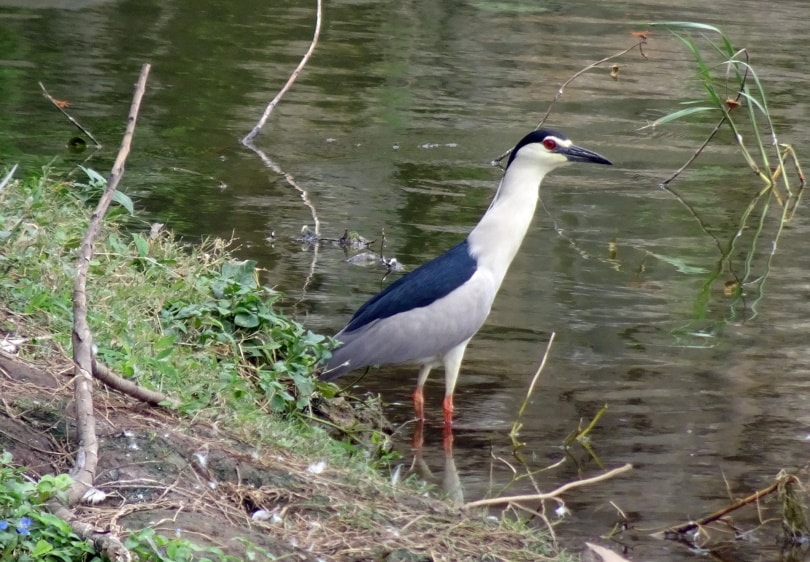
If you’re a bird lover or even a birdwatcher, then you probably already know there are more than a few birds with long legs out there to gaze upon. However, if you’ve ever wanted to know more about those long-legged birds or even where the best place is to see them, we’ve got you covered.
In this list, we’ll give you 15 of the most common and sometimes the most unique birds with long legs.

The 15 Birds with Long Legs
1. Black-Crowned Night Heron

| Scientific name | Nycticorax nycticorax |
| Wingspan | 45–46 inches |
| Length | 22–26 inches |
| Weight | 25.6–35.8 ounces |
The Black-Crowned Night Heron is found most often in North and South America, Africa, Europe, Asia, and the Falkland Islands. The species is carnivorous and are considered to be nocturnal.
This species has a life expectancy of 10 to 15 years in the wild. You can spot them most often in reservoirs, lakes, marshes, and streams. You can identify them by their light-grey bodies and black hooded heads. The Black-Crowned Night Heron has shorter legs than other Herons but legs that are longer than other birds.
2. Little Blue Heron

| Scientific name | Egretta Caerulea |
| Wingspan | 39–41 inches |
| Length | 20–32 inches |
| Weight | 14 ounces |
The Little Blue Heron is found in North, South, and Central America. This breed is carnivorous and has a life expectancy of around 14 years in the wild.
While these birds are technically called Herons, they more closely resemble Egrets. They have a slate-blue color that is very pretty and makes them pretty easy to identify for birdwatchers.
They like to catch their prey in grassy fields and shallow water. Their diet consists mainly of small fish, but they’ll dine on tadpoles, spiders, snakes, lizards, turtles, and various other small creatures as well.
3. Snowy Egret

| Scientific name | Egretta thula |
| Wingspan | 40 inches |
| Length | Around 2 feet |
| Weight | 13.1 ounces |
The Snowy Egret can be found in North, South, and Central America. This breed is carnivorous, and they have a life expectancy of between 18 and 22 years. They are small birds, but their snowy white appearance gives them just a touch of elegance.
While almost extinct at one time, a ban on hunting them has led to their numbers increasing. This breed likes to hunt in shallow waters, and they eat fish and insects.
4. White-Faced Ibis

| Scientific name | Plegadis Chihi |
| Wingspan | 35–36 inches |
| Length | 18–22 inches |
| Weight | 15.9–18.5 ounces |
The White-Faced Ibis can be found in North, South, and Central America. It has a life expectancy of 14 years and has a carnivorous diet.
With an overall color of bronze, this breed of bird is easily distinguishable to birdwatchers everywhere. It also has a long pink bill that slopes downward, giving it an even easier appearance for bird lovers to recognize.
The breed forages in shallow waters, where they pull worms out of the mud. They eat fish and other invertebrates as well.
5. Wood Stork

| Scientific name | Mycteria americana |
| Wingspan | 5 feet |
| Length | 3 feet |
| Weight | 5.5–7.3 pounds |
The Wood Stork can be found in North, South, and Central America. The breed is carnivorous and has a life expectancy of 20 to 30 years.
This breed can easily be identified by its featherless head. While they eat only the smallest of fish, one single Wood Stork can eat up to 400 pounds of fish during the breeding season. They do this in such a short amount of time that it’s an amazing thing to watch if you see it.
6. Sandhill Crane

| Scientific name | Grus canadensis |
| Wingspan | 5–7 feet |
| Length | 3–3.5 feet |
| Weight | 120–173 ounces |
The Sandhill Crane is found most often in North America. It is an omnivore and has an average life expectancy of 20 years.
This bird is most often found in wetlands and is a very opportunistic eater. They eat insects, rodents, and other things but are content to eat any type of vegetation as well.
You can recognize one by its trumpeting call, which is often used to talk to its mate, even when it isn’t mating season.
7. Cattle Egret
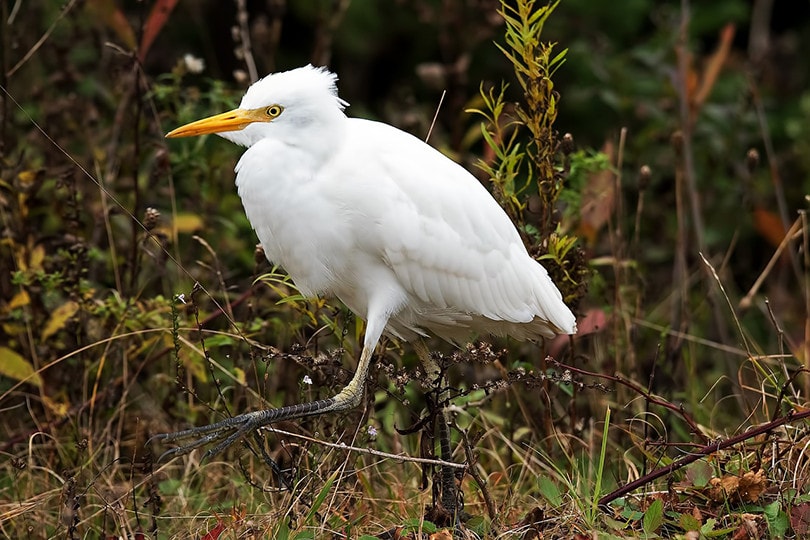
| Scientific name | Bubulcus Ibis |
| Wingspan | 35–38 inches |
| Length | 18–22 inches |
| Weight | 9,5–18.1 ounces |
The Cattle Egret can be found in North, South, and Central America like most of the long-legged birds on our list. They are carnivores and have an average life expectancy of 10 years. However, 70 years ago, you wouldn’t have been able to find this bird in America at all.
These birds exhibit behavior that mimics cow’s behavior, which is how they got their name. Their diet consists of whatever insects they can find in the grass.
8. Great Egret
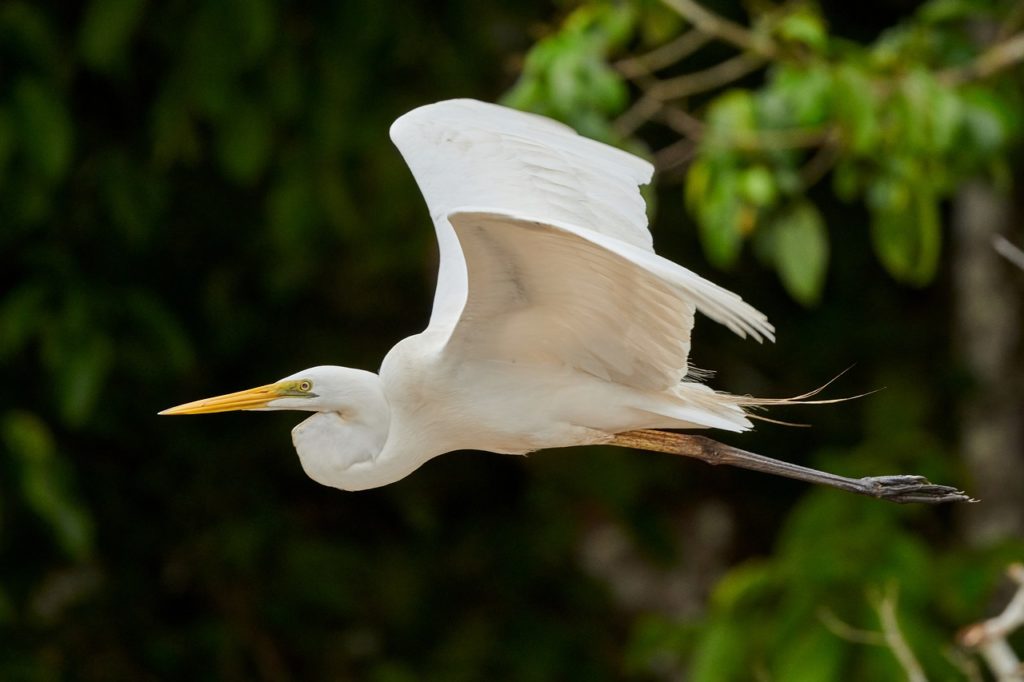
| Scientific name | Ardea alba |
| Wingspan | 4.4–5.7 feet |
| Length | 3.3 feet |
| Weight | 35.3 ounces |
The Great Egret is found in the “sunbelt” of the United States. They are carnivores and have a life expectancy of 15 years.
These are white, large birds that are found most often in freshwater. However, you can also find them in saltwater and wetlands, streams, and ponds. While they dine on fish the most, they’re not above eating other types of wildlife as well.
This breed is under government protection, so their numbers are steadily growing.
9. Yellow-Crowned Night Heron

| Scientific name | Nyctanassa violacea |
| Wingspan | 44 inches |
| Length | 24 inches |
| Weight | 25 ounces |
The Yellow-Crowned Night Heron is found only in the Americas. The species is carnivorous and has a life expectancy of around 6 years in the wild. This bird doesn’t have the grace that other Herons do, but it makes up for it with its blue-grey body and the yellow plumes it sports, which gives it a certain elegance and unique appearance.
Since these birds are mostly crab eaters, they can be spotted along the coast most often. However, they are solitary creatures and quite secretive as well.
10. Great Blue Heron
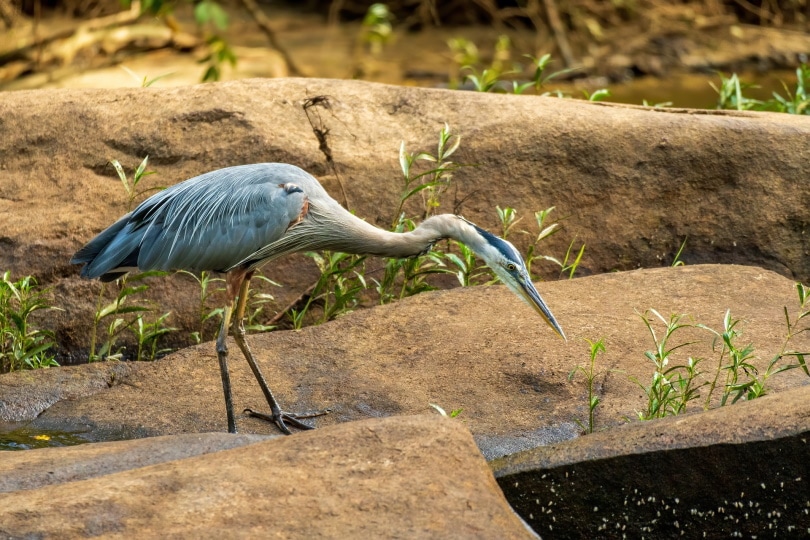
| Scientific name | Ardea herodias |
| Wingspan | 5.5–6.6 feet |
| Length | 3.5–4.5 feet |
| Weight | 88 ounces |
The Great Blue Heron is found in North, South, and Central America. The species is carnivorous and has a life expectancy of around 15 years in the wild.
This is the largest Heron in North America, coming in at between 3.5 to 4.5 feet. They have superior fishing skills, where they stand patiently waiting for the fish to come within striking distance, then they swallow the fish whole.
They will eat fish, mice, and insects, and though they hunt alone, they do live in large colonies any other time.
11. Green Heron

| Scientific name | Butorides virescens |
| Wingspan | 25.2–26.8 inches |
| Length | 16–18 inches |
| Weight | 7 ounces |
One of the smaller Heron breeds, the Green Heron, can be found in North, South, and Central America as well. They are carnivores and have a life expectancy of around 12 years in the wild.
They are solitary birds that you can spot in small bodies of water and dense foliage. They make a distinctive “kyow” sound when they take flight, which is how many bird watchers are alerted to their presence in time to see them before they fly away.
12. Striated Heron

| Scientific name | Butorides Striata |
| Wingspan | 25 inches |
| Length | 16–32 inches |
| Weight | 4.4–9.2 ounces |
The Striated Heron is found mostly in North, South, and Central America but they can be spotted in Japan, Australia, and Africa as well. They are carnivorous and have a life expectancy of about 7 years in the wild.
Though they belong to the Heron family, they have more traits in common with the Bittern family of birds instead. This breed is small, has drooping breasts, and all grey bodies. The best way to spot a Striated Heron is by its hunched posture, as this is how they hunt down their prey.
13. Reddish Egret
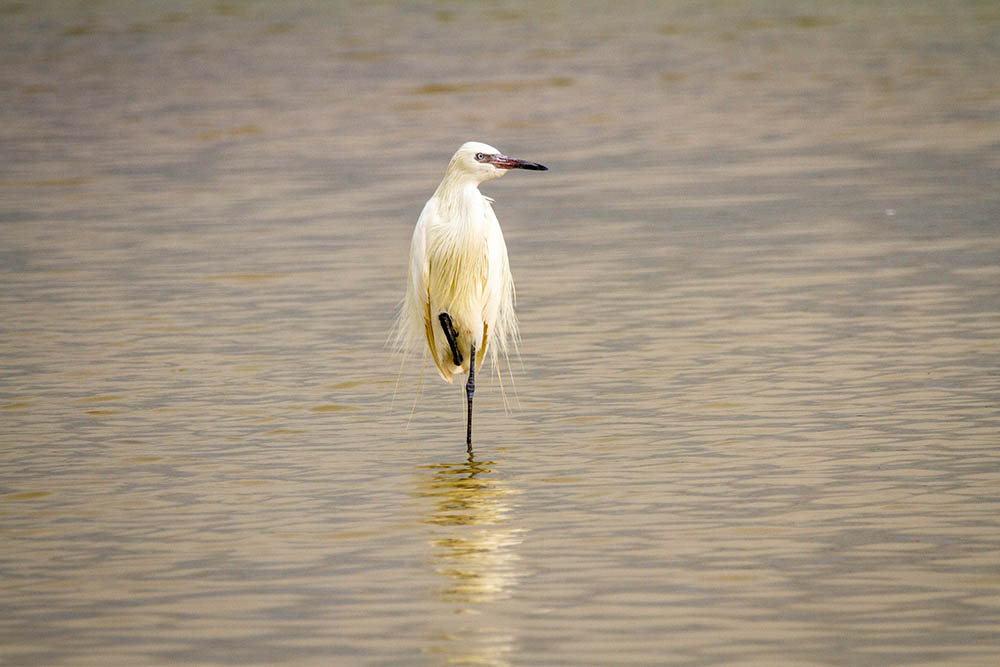
| Scientific name | Egretta rufescens |
| Wingspan | 46–49 inches |
| Length | 27–32 inches |
| Weight | 24.7–30 ounces |
The Reddish Egret can be found in Texas in the United States. This breed is carnivorous and has a life expectancy of about 12 years in the wild.
This is one of the rarest species of Egret birds in America due to hunting and habitat concerns. While this breed is a highly social bird, it can be strict when it comes to its hunting grounds. You can tell when you’ve spotted a Reddish Egret by their hyperactive eating patterns, which easily distinguishes them from other birds in their species.
14. Purple Gallinule

| Scientific name | Porphyrio martinicus |
| Wingspan | 21 inches |
| Length | 10–15 inches |
| Weight | 7.6–9.1 ounces |
The Purple Gallinule is a medium-sized bird with a life expectancy of 22 years. The bird’s low grating call has been likened to the sound a chicken makes. This breed of birds can be found in the Florida peninsula all year long.
This breed has also been known to forage while swimming and when walking along the riverbanks that it inhabits as well. The Purple Gallinule is most often found in swamps and wetlands.
- See also: 20 Birds With Orange Bellies
15. Whooping Crane

| Scientific name | Grus americana |
| Wingspan | 7.5 feet |
| Length | 4.3–5.2 feet |
| Weight | 9.9–19 pounds |
The Whooping Crane can reach a whopping 19 pounds in weight and has really long legs too. The Whooping Crane could once be spotted all across Northern America. Now, however, there’s only one wild population that can be seen in northern Canada and on the Texas coast.
This long-legged bird has a lifespan of between 22 and 24 years in the wild. However, if it’s in captivity, it can live longer when taken care of properly. This bird is also the tallest in North America. It’ll also eat anything that gets close to it, such as frogs, fish, mollusks, and whatever they can find in marshes and ponds.
Conclusion
This concludes our list of 15 birds with long legs. While there are many long birds in the world, to us, these are the most unique and certainly the most interesting to behold.
From the Snowy Egret to any of the Herons on our list, there’s sure to be a long-legged bird out there that you’d love to see, and we’ve shown you where to find them.
Featured Image Credit: Bishnu Sarangi, Pixabay
Table of Contents
About the Author Patricia Dickson
Patricia is an animal and coffee writer and a published author under the pen name Skylar McKinzie. When she isn’t writing, Patricia enjoys spending time with her two cats and dog. Since she was a young child, she has been a pet lover and enjoys nothing more than cuddling with her pets. Patricia loves sharing her knowledge of animals and finds joy in helping out at the local rescue shelter whenever she can.
Related Articles:
Monocular vs Telescope: Differences Explained (With Pictures)
10 Types of Hummingbirds in Arkansas (With Pictures)
8 Types of Hummingbirds in Nebraska (With Pictures)
5 Types of Hummingbirds in Idaho (With Pictures)
3 Types of Hummingbirds in Mississippi (With Pictures)
8 Types of Hummingbirds in Kansas (With Pictures)
5 Types of Hummingbirds in West Virginia (With Pictures)
5 Types of Hummingbirds in Ohio (With Pictures)
